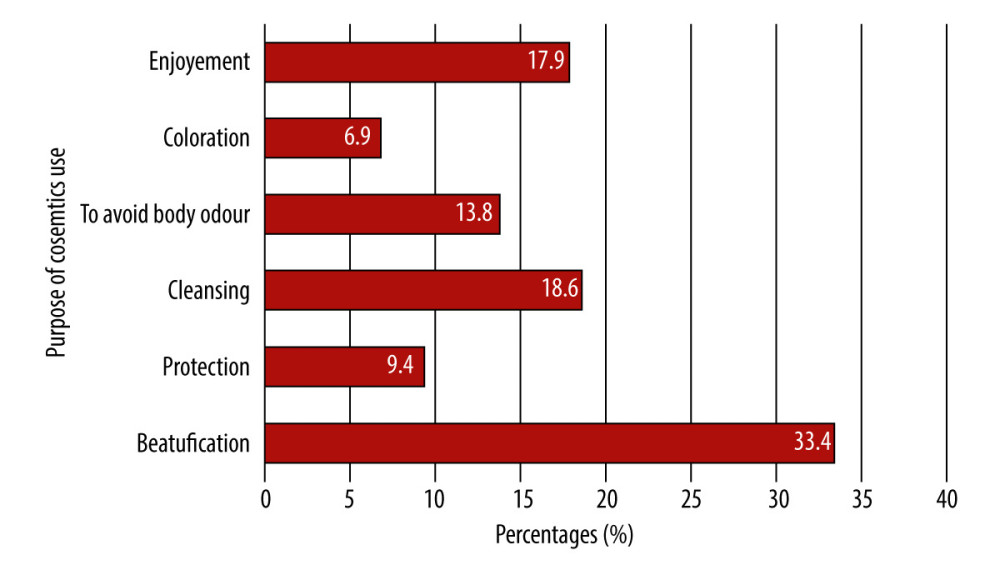29 March 2024: Human Study
Questionnaire-Based Study of 392 Women in Abbottabad, Pakistan, to Evaluate the Types of Cosmetic Products Purchased Between December 2018 and March 2019 and Their Associated Adverse Events
Fatima Nisar1ABCDEF, Atif Ali1ABDEF, Hira Shahid2CDF, Muhammad Mamoon Iqbal3CDF, Hira Khan4ABCDE, Qasim Khan1ABEF, Ayesha Iqbal56CDEFG, Sana Samreen7CDEFG, Wajid Syed8ABCDEFG*, Mahmood Basil A. Al-Rawi9CDEFGDOI: 10.12659/MSMBR.943048
Med Sci Monit Basic Res 2024; 30:e943048
Abstract
BACKGROUND: Cosmetics are applied topically to enhance appearance and are commonly used by women of all ages. Cosmetics contain many chemical agents, but the incidence of adverse reactions is low, possibly due to underreporting. This questionnaire-based study included 392 women to evaluate information on the types of cosmetics purchased between December 2018 and March 2019, their use by the women surveyed, and their associated adverse events.
MATERIAL AND METHODS: A cross-sectional study was conducted among 392 women in Abbottabad, Pakistan, using a pre-structured and validated questionnaire to evaluate information on the types of cosmetics, their use, and their associated adverse events. Part 1 of the study collected information about demographics. Part 2 contained a total of 11 items, and collected the frequency of use of cosmetic on skin and hair care products. Part 3 consisted of 4 items and collected information about problems encountered due to the use of cosmetics.
RESULTS: In the winter season, 47.7% (n=187) of women preferred chemical-based cosmetic products, while 30.9% (n=121) preferred Ayurvedic products. Among commonly used cosmetic products, 26.9% (n=106) of women used foundations. The most frequently used skin care product was face wash 39.5% (n=155). The most prevalent adverse events related to cosmetics were pimples (19.9%, n=78), redness (17.6%, n=69), and eye discomfort (15.8%, n=62). Furthermore, 51.3% (n=201) strongly agreed that cosmetics aid in getting a whiter complexion.
CONCLUSIONS: The survey concluded that most women preferred cosmetics with a chemical base, which are associated with rashes, redness, and acne. It is important to encourage cosmetovigilance and awareness campaigns among cosmetic product sellers and users.
Keywords: Cosmetics, Drug-Related Side Effects and Adverse Reactions, Economics, Practice Valuation and Purchase
Introduction
Seasonal and climatic changes can have an impact on the skin and make some skin diseases worse [1]. Individuals and patients who have skin diseases can find the severe temperatures in summer and winter months problematic [1]. It is common knowledge that factors including heavy perspiration, ultraviolet (UV) rays, wind, and cold can worsen skin that is already dry, cracked, and inflamed [2]. Additionally, altering one’s diet, wearing more layers of clothing, using protective emollients, such as corticosteroids or aqueous cream BP, and frequently switching between indoor and outdoor temperatures can aggravate conditions that already react poorly to even a small change in daily routine [3]. While the summer can be the worst time of the year for those who experience bouts of rosacea [4], the winter months bring other challenges as well.
Cosmetics are defined by the US Food and Drug Administration (FDA) as products that are anticipated for application to the human body for beautifying, cleansing, promoting a pleasant appearance, or modifying the physical appearance without disturbing the functions or the structure of the body [1]. Commonly used cosmetics include creams, lip cosmetics, powders, sunscreens, lotions, perfumes, face wash, nail polish, foundation, eye makeup, hair products, perfumes, deodorants, and bubble baths [2–4]. Hair cosmetic agents are the products used for cleansing, changing appearance, and protecting the hair. Lip cosmetics include lipstick, lip liner, lip gloss, lip balm, lip plumper, and lip primer. Lipsticks have been used to add texture and color to lips and often come in a variety of colors with different finishes, such as satin, matte, and luster [3].
Cosmetics have become crucial products and are used by most female populations, regardless of their age, marital status, occupation, and education [5]. However, due to the absence of formal and reliable reporting systems, little or no knowledge about the undesirable effects at the population level is available [6]. The associated effects of cosmetic products are damaging reactions attributable to their normal use [7]. Regular use of unreliable cosmetics imposes harmful effects, because they contain different harmful compounds. Skin care cosmetics can cause acne, burning, rashes, and itching. Allergic contact dermatitis in women due to the use of cosmetic products is very common [8]. Furthermore, fragrance blends, thiomersal, formaldehyde, neomycin, and balsam of Peru can include allergens and induce different skin sensitivities [9,10].
Elderly people are more likely to develop dermatitis in winter, which occurs mainly due to the use of antiperspirants and deodorants [11]. Photosensitivity, skin cancer, and premature aging occur because of UV radiation, which has led to the increased use of UV filters in skin care products. Hence, this becomes the main reason for an increased risk of photo contact allergy to UV filters [11]. Most of these cases are caused by the UVA-filtering benzophenone, dibenzoyl methane, isopropyl dibenzoyl methane, and butyl methoxy dibenzoyl methane. Other examples of photosensitizers are p-aminobenzoic acid (PABA), octyl dimethyl, and ethylhexyl-p-methoxycinnamate [11,12]. Some tiny nanoparticles, such as titanium dioxide and zinc oxide, penetrate the skin and can damage brain cells, and making them transparent in products creates a higher risks of developing this problem [12,13]. Cosmetovigilance emerged from the French Health Products Safety Organization to debate cosmetic product safety and to evaluate the procedures involved in gathering, analyzing, and tracking reports of unfavorable incidents that occur during or after the regular or reasonably anticipated use of cosmetic products [9,10].
Understanding consumer behavioral patterns, on the other hand, is critical to the success of corporate organizations. It aids individuals and the public in predicting future trends by evaluating patterns of purchase behavior and decisions [12,13]. Consumer behavior can be defined as the study of how, when, and why people purchase a specific product. According to Global Cosmetic Industry research, advanced education provided by businesses about the ingredients and advantages of products has made today’s consumers more aware of what they are putting on their bodies and more prepared to pay [1,13]. In the cosmetic market, it is critical to include both Western and Eastern countries to compare various people’s purchase habits for cosmetic items. Pakistan is a part of the Eastern culture, which has the highest proportion of women who buy cosmetics. To the best of our knowledge, no research has been conducted on how this population responds when the winter season arrives. Therefore, this questionnaire-based study included 392 women in Abbottabad, Pakistan, to evaluate the types of cosmetic products purchased between December 2018 and March 2019 and their associated adverse events.
Materials and Methods
STUDY DESIGN AND SETTING:
Before data collection, the Institutional Review Board at the Academic Unit of the Commission on Science and Technology for Sustainable Development in the South (COMSATS) University in Islamabad (CUI-Reg/Notif-1710/19/1998) approved this study. In addition, informed consent was acquired before completing the questionnaires. Participants were told about the study and given the assurance that the responses they submitted would remain confidential. No participants were coerced to provide an answer. Further, participants were allowed to leave the study at any time. In addition, this study followed the guidelines of the Declaration of Helsinki for human research.
A cross-sectional study was conducted in Sarban Hills, in Abbottabad, Khyber Pakhtunkhwa, Pakistan. According to Khyber Pakhtunkhwa Economic Zones Development and Management Company, it has a total population of approximately 1 332 912 and spans an area of approximately 179 653.5 km2, lying geographically between 34°09′N latitude and 73°13′E longitude at an altitude of 1260 m. It is located 110 km north of the capital Islamabad, 130 km from Rawalpindi, and 150 km northeast of Peshawar [14]. The study was conducted from December 2018 to March 2019 in Abbottabad, Pakistan. The data were collected using a simple random sampling technique. The inclusion criterion was women who were using cosmetics in the winter season. Exclusion criteria were vision problems (blindness) or inability to read and/or write.
SAMPLE SIZE ESTIMATION:
The sample size was calculated by the online calculator (
STUDY INSTRUMENT/QUESTIONNAIRE:
A questionnaire was developed and modified according to the needs of this study [15,16]. Part 1 of the questionnaire collected demographic information, including age, marital status, and educational status. Part 2 contained a total of 11 items and collected the frequency of use of the cosmetic products (daily/occasionally/rarely/never), frequency of use of various color cosmetics (lipsticks, foundation eyeliner, mascara, nail polish), skin care, and hair care products, and use of fragrance. We also collected the frequency of purchasing cosmetics, (once or twice in a month, once in 2 months, or as needed), types of cosmetics purchased, and the source of purchase. Participants were asked what they specifically look for in cosmetic products, whether they share cosmetics with others, whether they read the label for expiry date before buying the product, the purpose of using cosmetics, habits of removing makeup, and perspective of how cosmetics help an individual.
Part 3 consisted of 4 items and collected information about problems encountered due to the use of cosmetics assessed on a 5-point scale. The second question of part 3 collected information about the type of adverse events experienced after the use of cosmetics, what was done after the arrival of the effect, and who was consulted. All these questions were open-ended with multiple choice answers. Detailed information is presented in Table 1.
A pilot study was conducted with 20 women, whose responses were statistically evaluated to check the readability flow of the content using SPSS. Cronbach’s alpha value for reliability and consistency was assessed. The value of Cronbach’s alpha of 0.64, which is greater than 0.5 suggested that questionnaires are valid and reliable to use in the study.
DATA COLLECTION PROCEDURE:
A pre-structured and validated final questionnaire was individually distributed to the participants. The details and nature of the study were then explained. A researcher from the College of Pharmacy collected the responses. The participants were assured that the responses would be used only for research purposes, confidentiality would be maintained throughout the study, and they could withdraw from the study at any time. The filled questionnaires were collected upon completion. Of the 400 questionnaires issued to participants in the studies, 392 were collected, and 8 were eliminated owing to incompleteness.
STATISTICAL ANALYSIS:
Data obtained from the study were recorded and documented using SPSS, version 26. Descriptive statistics, such as percentages (%) and frequencies (n), were calculated.
Results
DEMOGRAPHIC CHARACTERISTICS:
All 400 questionnaires distributed to the study participants were collected, and 8 were discarded due to incompleteness, resulting in a response rate of 98%. The age of study participants ranged from 18 to 50 years, with a mean age of 34 years. The age distribution was as follows: 57.1% (n=224) were 18–27 years old, 35.2% (n=138) were 28–39 years old; and 7.7% (n=30) were 40–50 years old. Most participants were single, at 73.7% (n=289), and 26.3% (n=103) were married. Finally, 86.2% (n=338) attended university, 7.6% (n=30) attended college, and 6.1% (n=24) attended school (Table 2).
EFFECTS ON PURCHASE:
The effect on purchasing was examined, showing that the participants purchases of color cosmetics varied. Colored cosmetics were purchased as needed by 70.7%, once every 2 months by 27.8%, once a month by 0.8%, and twice a month by 0.8% of participants. Purchasing of skin care products was reported to be as needed by 80.1%, once in 2 months by 18.9%, once a month by 0.8%, and twice in a month by 0.3%. Purchase of hair care products was reported to be as needed by 88.5%, twice a month by 11.0%, and once a month by 0.5%. Purchasing of fragrances was reported to be as needed by 86.0%, once every 2 months by 13.5%, and once a month by 0.5% of participants. More details are shown in Table 3.
COMMONLY USED COSMETIC PRODUCTS:
Table 4 illustrates the various types of cosmetic products, including color cosmetics, skin care products, hair care products, and fragrances, used by the study participants. Frequently used color cosmetics were reported to be foundations by 26.9% (n=105), nail polish by 23% (n=93), lipstick by 21.5% (n=84), eyeliner by 16.4% (n=64), and mascara by 11.5% (n=45). Frequently used skin care products were reported to be face wash by 39.5% (n=155), moisturizers by 26.5% (n=104), sunscreens by 23.2% (n=91), body wash by 7.7% (n=30), and anti-aging creams by 3.1% (n=12). The most widely used hair care products were shampoos by 75.5% (n=296), conditioners by 17.1% (n=67), hair colors by 4.8% (n=19), styling gels/sprays by 1.8% (n=7), and protein packs by 0.8% (n=3). The frequently used fragrances were reported as deodorant sprays by 46.7% (n=183), perfumes by 36.7% (n=144), and deodorant sticks by 16.6% (n=65).
TYPES OF COSMETIC PRODUCTS AND THEIR SOURCE:
In this study, nearly half (47.7%) of participants preferred chemical-based products, 30.9% preferred Ayurvedic products, and 21.4% preferred both (Table 5). Among all study participants, 62% were buying cosmetics from local shops, 21.7% from supermarkets, 13% from drug retail outlets, and 3.3% from online sources. The following specifications were considered before buying the products: 57.1% looked for price, 24.7% looked for company name, 10.7% looked for natural ingredients/formulas, and 7.4% looked for packaging (Table 5).
SHARING COSMETICS AND READING THE LABEL FOR EXPIRY DATE BEFORE PURCHASE:
Regarding sharing their cosmetic products with others, 69.4% of participants reported they shared their cosmetic products with others, and 30.6% reported they did not share their cosmetics with others (Table 5). Furthermore, 73.7% of participants did read the expiry date before buying the product, while 26.3% did not read the expiry date before buying (Table 5).
FREQUENCY OF USE:
In our research, 53.3% (n=209) of participants reported using color cosmetics occasionally, 34.4% (n=135) reported using them daily, 9.4% (n=37) reported using them rarely, and 2.8% (n=11) reported no use. Meanwhile, 97.4% of participants reported using skin care products daily, 0.5% reported using them rarely, and 2.0% reported using them occasionally. The stated frequency of using hair care products was occasionally by 6.4%, rarely by 2.6%, and daily by 1.0%. The frequency of fragrances was reported as occasionally by 48.7%, rarely by 34.9%, daily by 12.5%, and never by 3.8% (Figure 1).
PERSONAL INTEREST:
In this study, 33.4% of women were using cosmetics for beautification purposes, 18.6% for cleansing, 17.9% for enjoyment, 13.8% for body odor, 9.4% for UV protection, and 6.9% for coloration. Of the total, 74% of participants had the habit of completely removing makeup before going to bed, while 26% had no habit of makeup removal before bed (Figure 2).
APPEARANCE OF ADVERSE EVENTS ASSOCIATED WITH COSMETIC PRODUCTS, ACTIONS TAKEN, AND CONSULTATION SOUGHT AFTER APPEARANCE OF ADVERSE EVENTS:
Table 1 illustrates adverse events associated with cosmetic products. The most common adverse events were pimples (19.9%), redness (17.6%), eye irritation (15.8%), rash (13.8%), pigmentation (7.7%), eczema (7.1%), burning (5.1%), nausea (5.1%), itching (4.8%), and dizziness (3.1%). Furthermore, Table 1 illustrates the actions taken and consultation sought after the onset of the adverse events. After the arrival of effects, 45.2% started using another product, 30.4% quit the products until the adverse event was gone, and 24.5% stopped using the product. After the arrival of adverse event, 65.3% consulted no one, 19.4% consulted medical specialists, 13.5% consulted general practitioners, and 1.8% consulted beauticians.
RESPONSES ON BENEFICIAL EFFECTS OF COMMONLY USED COSMETIC PRODUCTS:
The responses recorded by study participants on the beneficial effects of cosmetic products are documented in Table 6. Among the study population, 51.3% strongly agreed that cosmetics help to get whiter complexion, 44.9% agreed that cosmetics contribute toward looking trendy and fashionable, 37% agreed on cosmetics role in the removal of acne scars for smooth skin, 31.1% agreed that cosmetics help to remove pimples and blemishes, and 29.3% agreed that cosmetics help to get high social rank (Table 6).
RESPONSES ON PROBLEMS ASSOCIATED WITH COMMONLY USED COSMETIC PRODUCTS:
The responses to problems associated with commonly used cosmetic products are shown in Table 7. According to the present findings, 60.2% of participants were neutral to the statement that harmful substances can be absorbed through the skin and can lead to organ failure, 52.8% of participants strongly agreed that chemical dyes cause white hair, 51% strongly agreed that inappropriate use of cosmetics causes skin problems, 47.2% agreed to an increased risk of sunburn due to cosmetic use, 29.1% agreed that hair dying in pregnant and breastfeeding women has harmful effects, 26.3% reported a neutral response on suppression of the immune system, and 16.8% strongly agreed to the suppression of the immune system due to the use of cosmetics (Table 7).
Discussion
Various cosmetic products are being used to improve physical appearance; however, using cosmetics is associated with adverse events [1,17]. Creating adequate awareness and knowledge about the impacts produced by the use of as well as the sharing of these cosmetics can help in avoiding complications associated with cosmetics. In this study, 34.4% of participants reported using cosmetics daily; among the users, 47.7% preferred chemical-based products, while 30.9% of preferred Ayurvedic products. Furthermore, 33.4% were using cosmetics for beautification purposes. The most used color cosmetics were foundations, reported by 26.9%, nail paints by 23%, lipstick by 21.5%, eyeliner by 16.4%, and mascara by 11.5%. These findings were similar to earlier findings by Lucca et al [1], who reported makeup products (24.56%) and personal care products (22.43%) were the most frequently used cosmetics by the study population. Furthermore, previous research has shown that younger women use cosmetics more than older women [18], which is consistent with our present findings, in which 190 young women aged 18 to 27 used cosmetics. These findings could be related to a high incidence of use, and increased knowledge of the adverse events of cosmetics is required among the younger age group. Furthermore, the high usage of cosmetics in this age range is attributed to a need for self-care and beautification [1]. Seasonal and climatic variations can affect the skin and exacerbate pre-existing problems, which can be the reasons to use cosmetics.
The present study showed that women purchased cosmetic products according to their preferences and needs. Most women purchased color cosmetics once or twice a month. They were purchasing skin and hair care products twice a month or once in 2 months, while they purchased fragrance as per their need. Most women purchased cosmetics to get a fair complexion and beautification. These findings were comparable to earlier findings in which the author reported that women use cosmetics to look more attractive and to hide the imperfections of their appearance, to influence their self-perceptions [16].
An earlier study showed that many facial and hair cosmetics contain high amounts of heavy metals, demonstrating that the accumulation of heavy metals in internal organs and skin causes toxicity [17]. In the present study, most women reported using chemical-based cosmetic products. Studies showed that chemical-based cosmetic products cause more adverse events than do Ayurvedic products [18,19]. The effects of cosmetics are related to the source from which they are bought and with the nature of products [20,21]. Further, in the present study, 62% of women bought their cosmetic products from local shops because of the product’s nature and their low budget, and 21.7% bought their cosmetic products from the supermarket, perhaps with the belief that products from the supermarket are better than those at local shops. The most common adverse events associated with cosmetic use in the present study were pimples (19.9%), redness (17.6%), eye irritation (15.8%), rash (13.8%), pigmentation (7.7%), eczema (7.1%), burning (5.1%), nausea (5.1%), itching (4.8%) and dizziness (3.1%), which is consistent with previous findings by Di Giovanni et al and Lucca et al. For instance, Di Giovanni et al reported that 36.3% of participants had burning and 32.9% had itching [22]. In addition, earlier findings reported headache (40.3%) followed by nausea (24.2%) as other adverse events of cosmetic use [22]. On the other hand, redness of the skin (19%), pimples (15%), and itching (13%) was reported by Lucca et al, in 2020 [1].
In the present study, 69.4% of women were sharing their cosmetics with others at home. Those who share cosmetics have more adverse events than those who did not share their cosmetics [23]. Sharing cosmetics means sharing all infections that are present on the skin with others. According to a study, sharing cosmetics with others caused 50% of the women to develop adverse events from the cosmetics [24]. Women who did not read the label are more prone to cosmetic adverse events because of lack of knowledge [25]. In our study, most participants read the expiry date on the label before buying. It was recently reported by the US FDA and the European Union’s Restriction on Hazardous Substances directive that some cosmetic materials used by humans contain hazardous substances [26]. For these reasons, there is a growing concern that some of the cosmetic products used by humans contain hazardous substances that are injurious to health [27].
The present study had some limitations. First and foremost, the fact that the results were based on a self-administered survey may have increased the possibility of biases, such as social desirability bias. Further, estimates of adverse events of cosmetics reported by participants were dependent on self-reports, which could be influenced by recollection bias, resulting in underestimation. Second, the findings are not representative of other regions in the country and cannot be extended globally, because they were gathered from a particular region of Pakistan. Despite these limitations, our research reveals that to avoid adverse events related to the use of cosmetics, women must have knowledge and awareness of how to use them. To avoid adverse events, subsequent cosmetics containing medicinal ingredients should be used under the supervision of a healthcare provider. As a result, more research is needed to understand how women use and behave with cosmetics. Furthermore, this study can provide a solid foundation for future domain-specific research.
Conclusions
Reliable data on temperature change, especially in winter, are needed to determine the health risks posed by the ingredients of cosmetic products, such as parabens and phthalates. Most participants in this study reported using chemical-based cosmetic products and sharing their cosmetics. Furthermore, participants strongly agreed that inappropriate use of cosmetics causes adverse reactions on the skin. In addition, it was found that every user of cosmetics had at least 1 adverse effect. The most commonly reported adverse events from the cosmetics were redness, rashes, eye irritation, and pigmentation. This implies the need to have cosmetic use-related safety guidelines. There is a need for systematic monitoring of the safety of cosmetic products. This will ensure the quality of cosmetics and keep a check on the safe chemical limits for consumer usage, protecting public health in the long term in Pakistan.
Tables
Table 1. Self-reported effects and action after their occurrence among women in Abbottabad between December 2018 and March 2019 (n=392).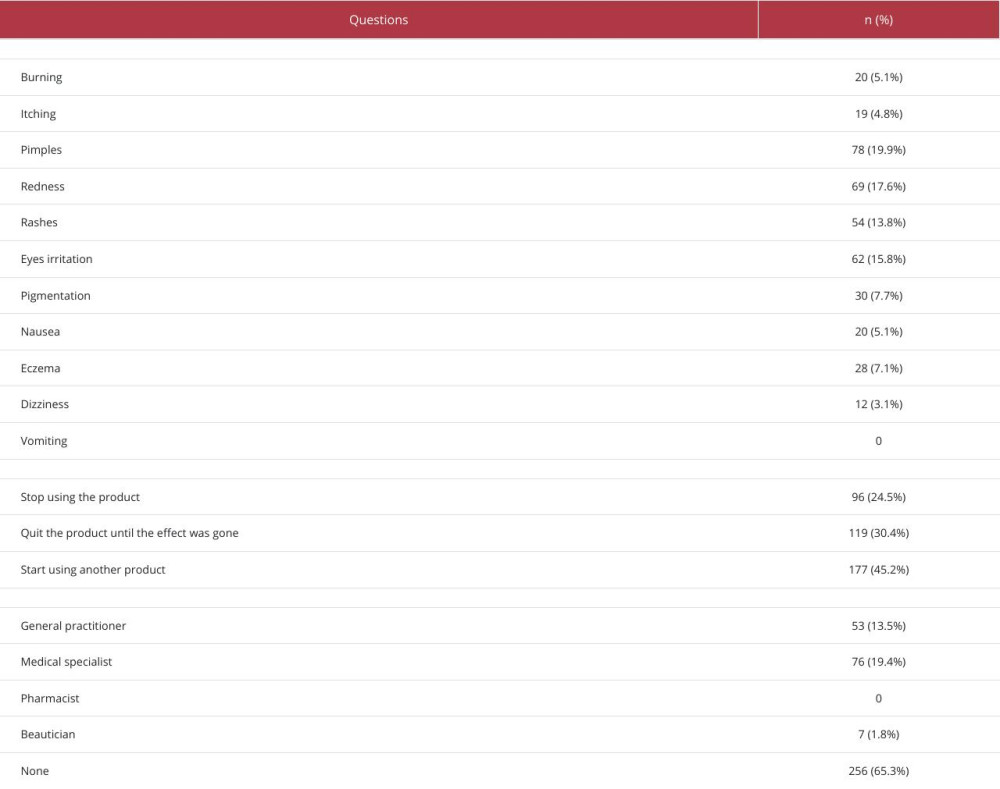 Table 2. Demographic characteristics of cosmetic users in Abbottabad between December 2018 and March 2019 (n=392).
Table 2. Demographic characteristics of cosmetic users in Abbottabad between December 2018 and March 2019 (n=392).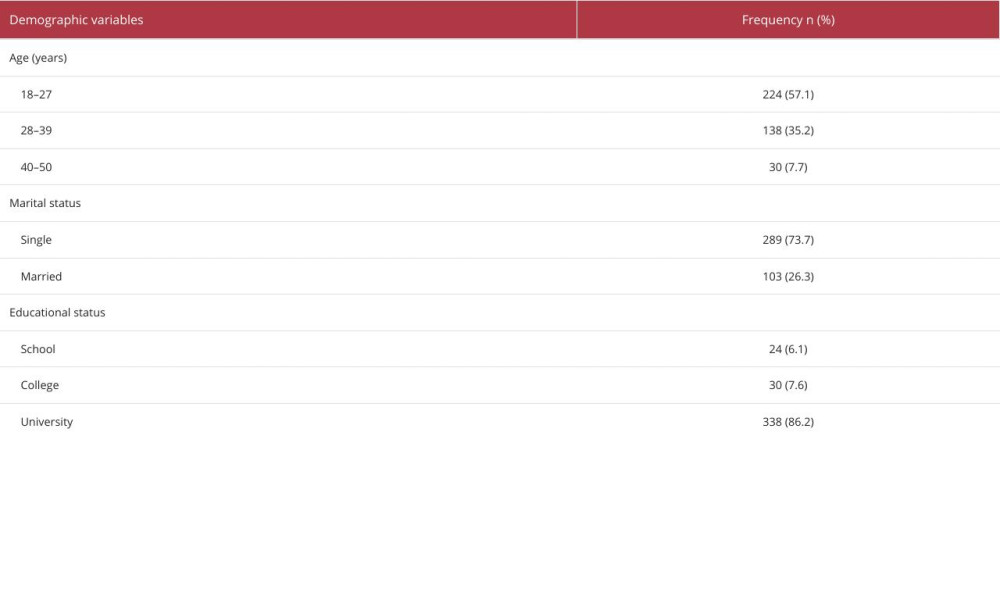 Table 3. Purchase period of cosmetic products among women of Abbottabad between December 2018 and March 2019 (n=392).
Table 3. Purchase period of cosmetic products among women of Abbottabad between December 2018 and March 2019 (n=392).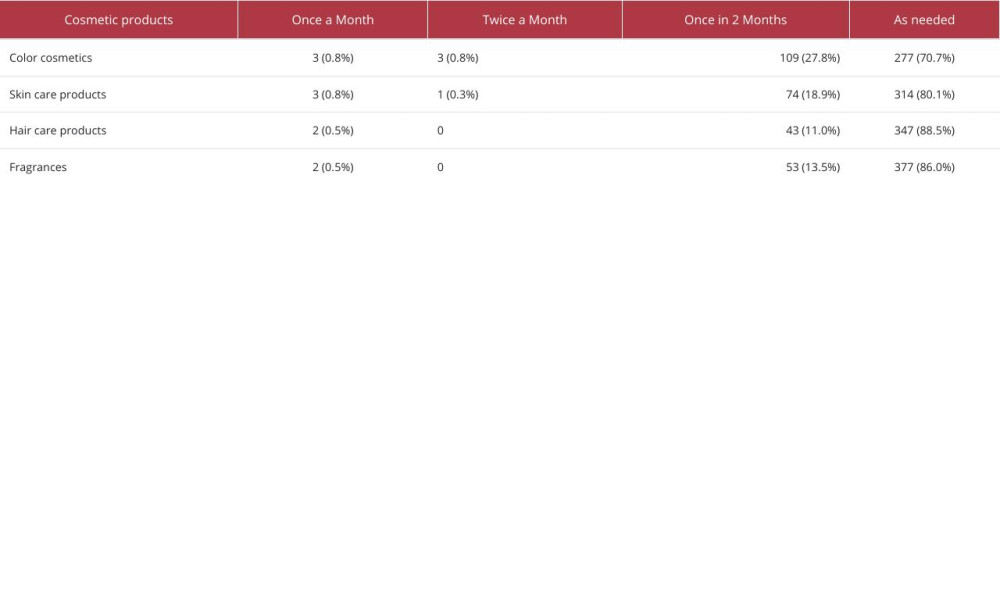 Table 4. Commonly used beauty cosmetic products among women in Abbottabad between December 2018 and March 2019 (n=392).
Table 4. Commonly used beauty cosmetic products among women in Abbottabad between December 2018 and March 2019 (n=392).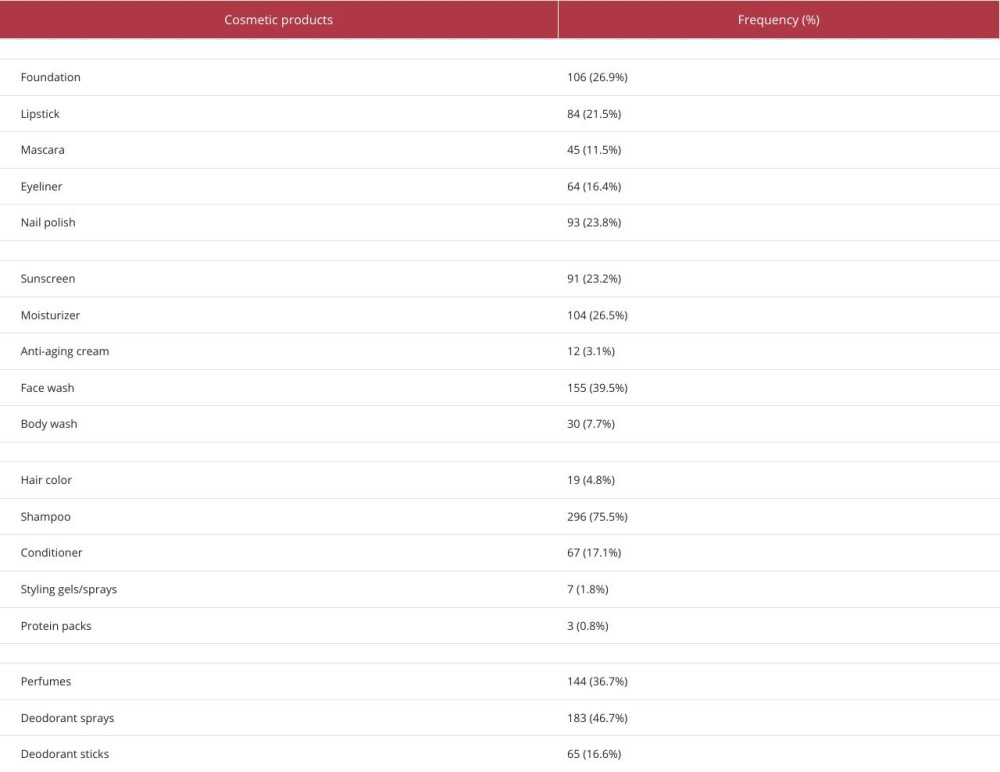 Table 5. Cosmetic purchase and usage behavior among women in Abbottabad between December 2018 and March 2019 (n=392).
Table 5. Cosmetic purchase and usage behavior among women in Abbottabad between December 2018 and March 2019 (n=392).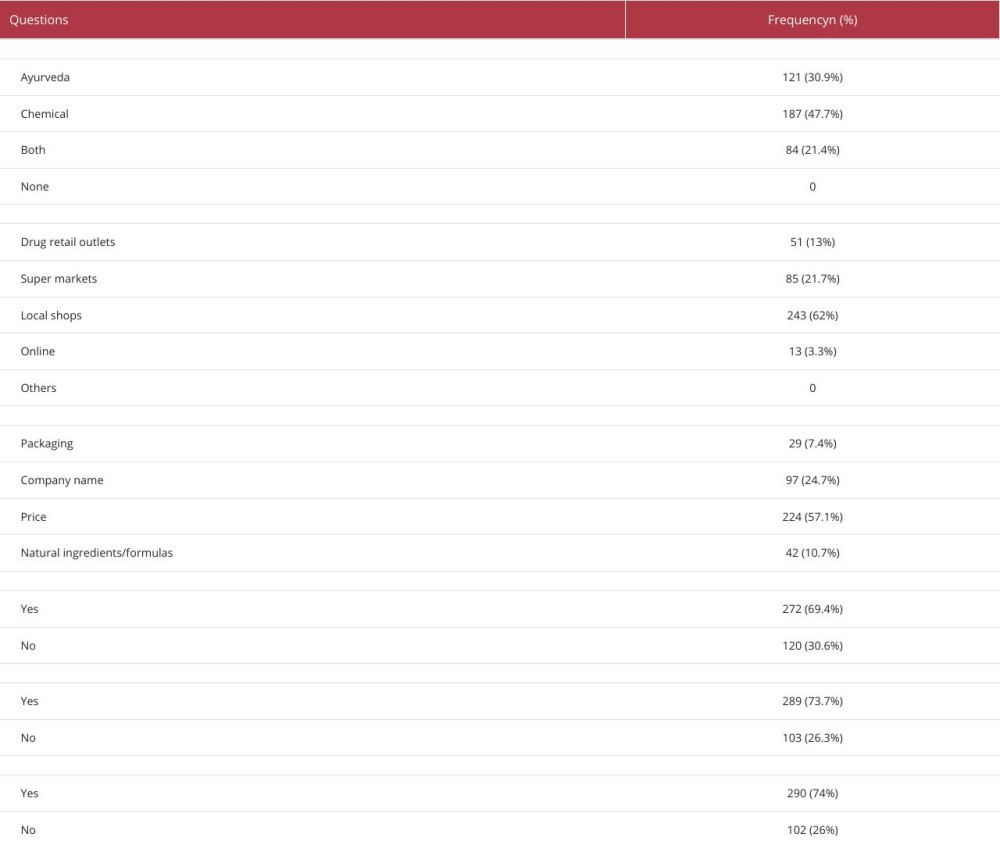 Table 6. Responses on beneficial effects of commonly used cosmetics between December 2018 and March 2019 (n=392).
Table 6. Responses on beneficial effects of commonly used cosmetics between December 2018 and March 2019 (n=392).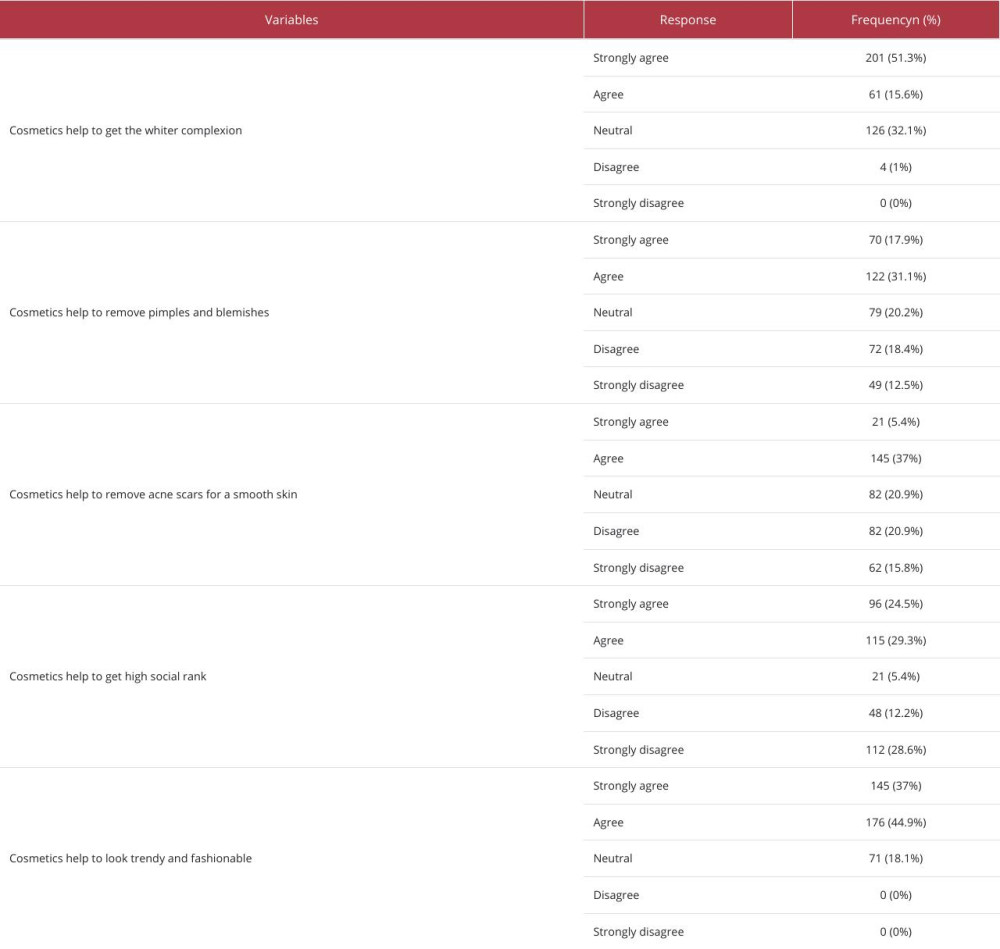 Table 7. Responses on problems associated with commonly used cosmetic products between December 2018 and March 2019 (n=392).
Table 7. Responses on problems associated with commonly used cosmetic products between December 2018 and March 2019 (n=392).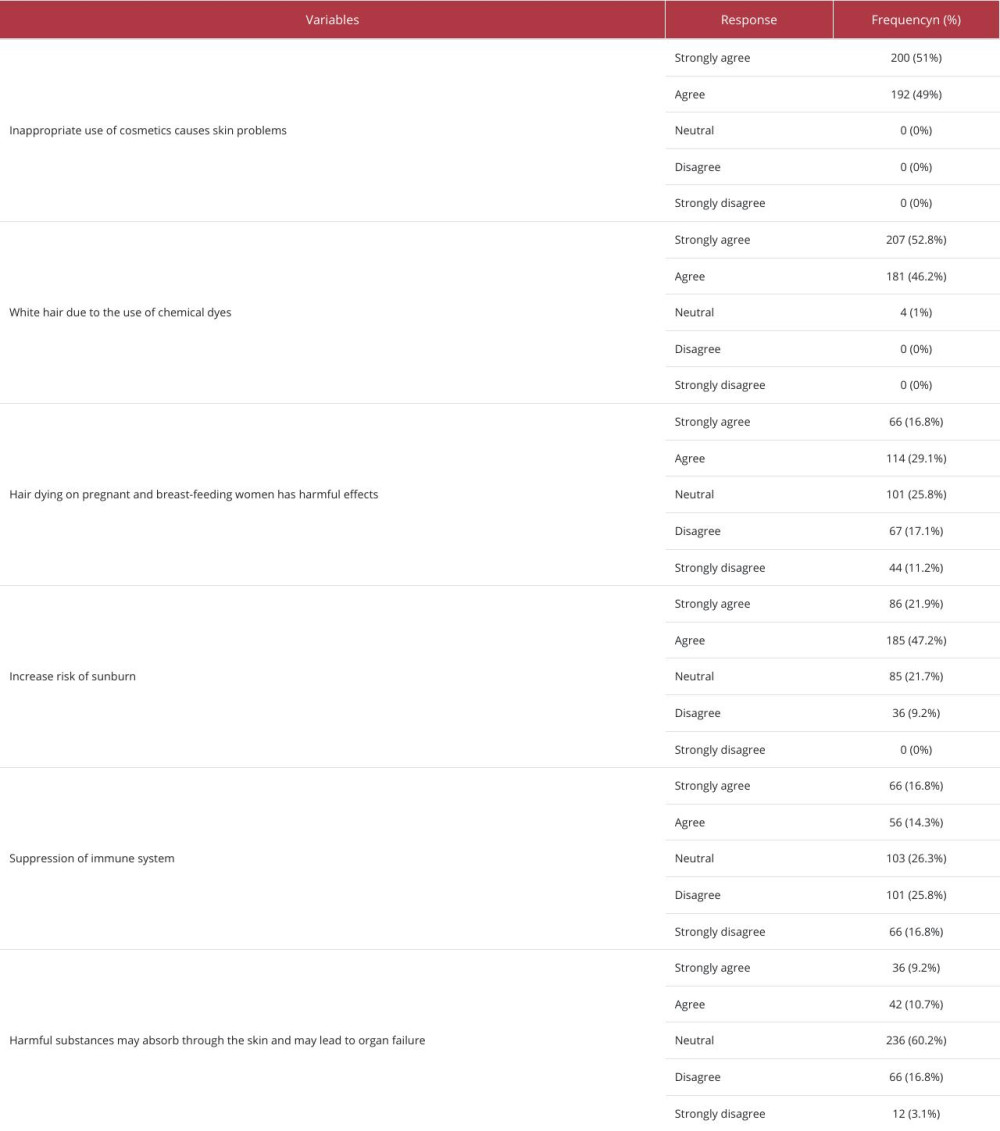
References
1. Lucca JM, Joseph R, Hussain Al Kubaish Z, An observational study on adverse reactions of cosmetics: The need to practice the Cosmetovigilance system: Saudi Pharm J, 2020; 28(6); 746-53
2. Termini RB, Tressler L, American beauty: An analytical view of the past and current effectiveness of cosmetic safety regulations and future direction: Food Drug Law J, 2008; 63(1); 257-74
3. Mohiuddin AK: An extensive review of cosmetics in use, 2029, Open Scientific Publishers (OSP) Available from: https://www.ospublishers.com/an-extensive-review-of-cosmetics-in-use.html
4. Draelos ZD, Active agents in common skin care products: Plast Reconstr Surg, 2010; 125(2); 719-24
5. Khraim HS, The influence of brand loyalty on cosmetics buying behavior of UAE female consumers: Int J Mark Stud, 2011; 3(2); 123
6. Kotby FA, Beayari SM, Alsalmi KA, Knowledge and practice of women toward the adverse effects of cosmetics in Saudi Arabia: International Journal of Medicine in Developing Countries, 2020; 4(1); 113
7. Khan AD, Alam MN, Cosmetics and their associated adverse effects: A review: Journal of Applied Pharmaceutical Science and Research, 2019; 2(1); 1-6
8. Zirwas MJ, Contact dermatitis to cosmetics: Clin Rev Allergy Immunol, 2019; 56(1); 119-28
9. Toklu HZ, Antigua A, Lewis V, Cosmetovigilance: A review of the current literature: J Family Med Prim Care, 2019; 8(5); 1540-45
10. Vigan MNew allergens in cosmetics. Cosmetovigilance: Ann Dermatol Venereol, 1997; 124(8); 571-75 [in French]
11. Harper J, Oranje AP: Harper’s textbook of pediatric dermatology, 2019, John Wiley & Sons
12. Smijs TG, Pavel S, Titanium dioxide and zinc oxide nanoparticles in sunscreens: Focus on their safety and effectiveness: Nanotechnol Sci Appl, 2011; 4; 95-112
13. Bachkirov AA, Towards a better understanding of organizational buying behavior across cultures: Empirical evidence from the Arabian Gulf: J Bus Ind Mark, 2019; 34(7); 1521-32
14. Ijaz F, Iqbal Z, Rahman IU, Investigation of traditional medicinal floral knowledge of Sarban Hills, Abbottabad, KP, Pakistan: J Ethnopharmacol, 2016; 179; 208-33
15. Szalaty P, Derda I, “Revolutionizing beauty industry”: Co-creation and customer engagement for brand image development: International Journal of Marketing, Communication and New Media, 2020; 8(14); 45-69
16. Meharie BG, Ambaye AS, Thaimanot YM, A cross sectional study on assessment of cosmetics utilization and self-reported adverse reactions among Wollo University, Dessie Campus Female Students, Dessie, North East Ethiopia: Eur J Pharm Med Res, 2014; 2; 49-63
17. Draelos ZD, Cosmetics: The medicine of beauty: J Cosmet Dermatol, 2015; 14(2); 91
18. Sendrasoa FA, Ranaivo IM, Andrianarison M, Misuse of topical corticosteroids for cosmetic purpose in Antananarivo, Madagascar: Biomed Res Int, 2017; 2017; 9637083
19. Bocca B, Pino A, Alimonti A, Forte G, Toxic metals contained in cosmetics: A status report: Regul Toxicol Pharmacol, 2014; 68(3); 447-67
20. Hazra J, Panda AK, Concept of beauty and ayurveda medicine: J Clin Exp Dermatol Res, 2013; 4(2); 1000178
21. Tejal P, Nishad D, Amisha J, Cosmetics and health: Usage, perceptions and awareness: Bangladesh Journal of Medical Science, 2013; 12(4); 13330
22. Di Giovanni C, Arcoraci V, Gambardella L, Sautebin L, Cosmetovigilance survey: Are cosmetics considered safe by consumers?: Pharmacol Res, 2006; 53(1); 16-21
23. Dibaba H, Yadesa D, Legesse B, Cosmetics utilization pattern and related adverse reactions among female university students: Int J Pharm Sci Res, 2013; 4(3); 997-1004
24. Vigan M, Castelain F, Cosmetovigilance: Definition, regulation and use “in practice”: Eur J Dermatol, 2014; 24(6); 643-49
25. Gondal MA, Seddigi ZS, Nasr MM, Gondal B, Spectroscopic detection of health hazardous contaminants in lipstick using Laser Induced Breakdown Spectroscopy: J Hazard Mater, 2010; 175(1–3); 726-32
26. Eichler CMA, Cohen Hubal EA, Little JC, Assessing human exposure to chemicals in materials, products and articles: The international risk management landscape for phthalates: Environ Sci Technol, 2019; 53(23); 13583-97
27. Pastor-Nieto MA, Gatica-Ortega ME, Ubiquity, hazardous effects, and risk assessment of fragrances in consumer products: Curr Treat Options Allergy, 2021; 8(1); 21-41
Figures
Tables
 Table 1. Self-reported effects and action after their occurrence among women in Abbottabad between December 2018 and March 2019 (n=392).
Table 1. Self-reported effects and action after their occurrence among women in Abbottabad between December 2018 and March 2019 (n=392). Table 2. Demographic characteristics of cosmetic users in Abbottabad between December 2018 and March 2019 (n=392).
Table 2. Demographic characteristics of cosmetic users in Abbottabad between December 2018 and March 2019 (n=392). Table 3. Purchase period of cosmetic products among women of Abbottabad between December 2018 and March 2019 (n=392).
Table 3. Purchase period of cosmetic products among women of Abbottabad between December 2018 and March 2019 (n=392). Table 4. Commonly used beauty cosmetic products among women in Abbottabad between December 2018 and March 2019 (n=392).
Table 4. Commonly used beauty cosmetic products among women in Abbottabad between December 2018 and March 2019 (n=392). Table 5. Cosmetic purchase and usage behavior among women in Abbottabad between December 2018 and March 2019 (n=392).
Table 5. Cosmetic purchase and usage behavior among women in Abbottabad between December 2018 and March 2019 (n=392). Table 6. Responses on beneficial effects of commonly used cosmetics between December 2018 and March 2019 (n=392).
Table 6. Responses on beneficial effects of commonly used cosmetics between December 2018 and March 2019 (n=392). Table 7. Responses on problems associated with commonly used cosmetic products between December 2018 and March 2019 (n=392).
Table 7. Responses on problems associated with commonly used cosmetic products between December 2018 and March 2019 (n=392). Table 1. Self-reported effects and action after their occurrence among women in Abbottabad between December 2018 and March 2019 (n=392).
Table 1. Self-reported effects and action after their occurrence among women in Abbottabad between December 2018 and March 2019 (n=392). Table 2. Demographic characteristics of cosmetic users in Abbottabad between December 2018 and March 2019 (n=392).
Table 2. Demographic characteristics of cosmetic users in Abbottabad between December 2018 and March 2019 (n=392). Table 3. Purchase period of cosmetic products among women of Abbottabad between December 2018 and March 2019 (n=392).
Table 3. Purchase period of cosmetic products among women of Abbottabad between December 2018 and March 2019 (n=392). Table 4. Commonly used beauty cosmetic products among women in Abbottabad between December 2018 and March 2019 (n=392).
Table 4. Commonly used beauty cosmetic products among women in Abbottabad between December 2018 and March 2019 (n=392). Table 5. Cosmetic purchase and usage behavior among women in Abbottabad between December 2018 and March 2019 (n=392).
Table 5. Cosmetic purchase and usage behavior among women in Abbottabad between December 2018 and March 2019 (n=392). Table 6. Responses on beneficial effects of commonly used cosmetics between December 2018 and March 2019 (n=392).
Table 6. Responses on beneficial effects of commonly used cosmetics between December 2018 and March 2019 (n=392). Table 7. Responses on problems associated with commonly used cosmetic products between December 2018 and March 2019 (n=392).
Table 7. Responses on problems associated with commonly used cosmetic products between December 2018 and March 2019 (n=392). Most Viewed Current Articles
15 Jun 2022 : Clinical Research
Evaluation of Apical Leakage After Root Canal Obturation with Glass Ionomer, Resin, and Zinc Oxide Eugenol ...DOI :10.12659/MSMBR.936675
Med Sci Monit Basic Res 2022; 28:e936675
07 Jul 2022 : Laboratory Research
Cytotoxicity, Apoptosis, Migration Inhibition, and Autophagy-Induced by Crude Ricin from Ricinus communis S...DOI :10.12659/MSMBR.936683
Med Sci Monit Basic Res 2022; 28:e936683
01 Jun 2022 : Laboratory Research
Comparison of Sealing Abilities Among Zinc Oxide Eugenol Root-Canal Filling Cement, Antibacterial Biocerami...DOI :10.12659/MSMBR.936319
Med Sci Monit Basic Res 2022; 28:e936319
08 Dec 2022 : Original article
Use of Estimated Glomerular Filtration Rate and Urine Albumin-to-Creatinine Ratio Based on KDIGO 2012 Guide...DOI :10.12659/MSMBR.938176
Med Sci Monit Basic Res 2022; 28:e938176










